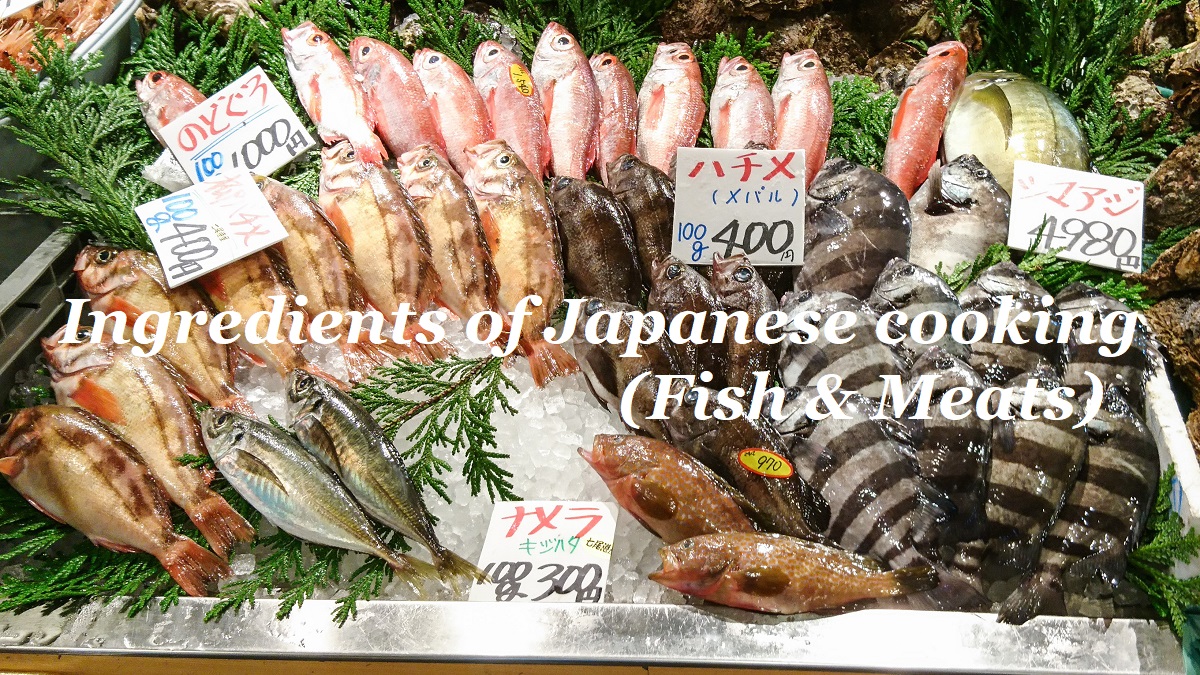Ingredients of Japanese cooking (Fish & Meats)
Fish
Because Japan is a country surrounded by sea, fish are important ingredients.
Most Japanese know the names and tastes of various fish.
When we enjoy at a sushi restaurant, we must order by Japanese name of fish.
As the cooking of fish, there are various methods such as Sashimi (raw fish), broiling, boiling in Japanese soup, tenpura and deep-frying.
By the way, the words of most fishes are short in Japanese language, so probably you are easy to learn.
And many of them are described in one Kanji character (Chinese character) and a part of the character includes a character "魚" meaning "fish".
Because most of them aren't taught in school, reading the characters in sushi bar is an intellectual game for Japanese people.
Fish through all seasons
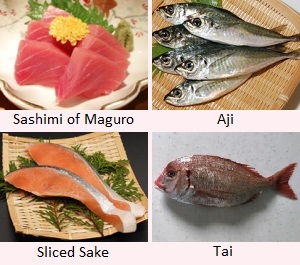
- Maguro (鮪, Tuna) : Maguro is the most popular fish and is the main ingredient for Sushi or Sashimi.
In Japan, it has been eaten since ancient times.
There are several varieties.
Kuro-maguro is big and expensive.
Mebachi, Binnaga and Kihada are relatively cheap. - Aji (鯵, Horse mackerel) : Aji is one of the fish that Japanese people have eaten.
Mainly, it is used as broiled fish or deep-fried fish. - Sake (鮭, Salmon) : Sake is also called as "Shake" in Japanese.
It is used for broiled fish or various dishes. - Tai (鯛, Red seabream) : Tai has white meat and pink skin.
It is mainly used for Sushi, Sashimi and broiled fish.
Because of the pink color, tai has been used as an auspicious fish in Japan.
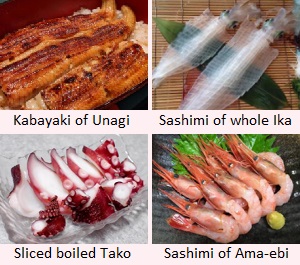
- Unagi (鰻, Eel) : Unagi is a popular fish for Japanese people, but it is expensive.
It is fatty and is especially eaten a lot in summer.
The main method of cooking is "Kabayaki" that eel is broiled on a grill after being dipped in a sweet soy sauce-based sauce. broiled on a grill - Ika (烏賊, Squid, Cuttlefish) : Ika is the popular fish in Japan.
Raw ika is for Sushi and Sashimi.
And it is used as an ingredient of boiled dish and fried dish. - Tako (蛸, Octopus) : Tako is one of popular fish for Japanese people.
After boiling in water, the part of legs are eaten mainly.
It is used directly for sashimi and sushi.
And it is used as an ingredient of boiled dish and fried dish. - Ebi (海老, Shrimp, Prawn) : Ebi is also popular food. The price is not expensive.
There are several varieties.
"Ise-ebi" (Japanese spiny lobster) is the king of "Ebi" in Japan and is expensive.
"Kuruma-ebi" (Japanese tiger prawn) is a popular prawn in Japan.
"Ama-ebi" (Sweet shrimp) is used raw and is eaten as sashimi and sushi.
Fish in spring
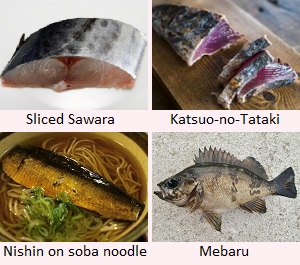
- Sawara (鰆, Japanese Spanish mackerel) : Sawara is a big fish, and the flesh is white and soft.
It is mainly cooked by broiling. - Katsuo (鰹, Bonito) : Katsuo is used for making "Katsuobushi" to take Japanese soup stock.
But Katsuo in spring is used for "Katsuo-no-Tataki".
It is cooked by broiling the surface of the block of Katsuo flesh.
And it is sliced and is eaten with various vegitable like salad. - Nishin (鰊, Pacific herring) : Until early 20th century, a lot of Nishin were caught around Japan, but its catch has fallen now.
It is used for various dishes. - Mebaru (鮴, Japanese rockfish) : Mebaru is a fish with white flesh.
The main cooking is to boiling in the soup of dashi, shoyu and suger.
Fish in summer
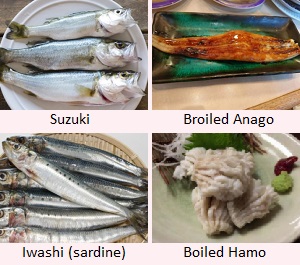
- Suzuki (鱸, Japanese sea bass) : Suzuki is a big fish with white flesh.
It is cooked by broiling and the other various methods. - Anago (穴子, Whitespotted conger) : Anago is similar to eel, but has lower fat than eel.
Broiled Anago with the sauce of shoyu and sugar is a popular cooking and is used for sushi.
And it is used for tenpura. - Iwashi (鰯, Sardine) : Iwashi is the fish eaten in the world.
In Japan, it is eaten by broiling and various methods.
And, fresh Iwashi is eaten as Sashimi. - Hamo (鱧, Dagger-tooth pike conger) : Hamo is a fish like eel and have sharp teeth.
It is mainly used the dish in Kyoto and Osaka.
It has a lot of small bones, so it is cooked by making many small cuts.
Fish in autumn and winter
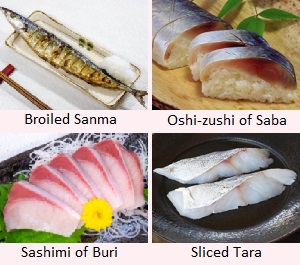
- Sanma (秋刀魚, Pacific saury) : Sanma is a popular fish and is a symbol of food in Japanese autumn.
Recently, neighboring countries such as China are consuming tasty sanma, so the catch is decreasing.
The best cooking is broiling over an open fire and it one of autumn features in Japan. - Saba (鯖, Mackerel) : Saba is often served in a common Japanese meal.
Broiling on the fire or boiling in miso sauce are the main methods of cooking.
And salted and vinegared saba is used for pressed sushi (Oshi-zushi). - Buri (鰤, Japanese amberjack) : Buri is the fatty fish and the best season for cooking is winter.
Sashimi and broiling are the main cooking method.
Young Buri is called as Hamachi, and is used for sashimi and sushi. - Tara (鱈, Cod) : Tara is a fish in winter.
The flesh is white and soft.
Mainly, it is used for broiling or a food of nabemono (Cooking in a pot on a table).
The soft roe of Tara is also used as a delicacy.
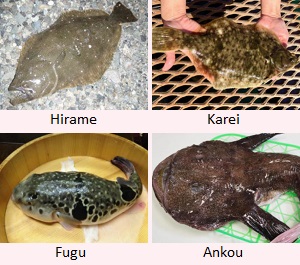
- Hirame (鮃, Olive flounder) : Hirame is a flat fish and both eyes are on the left side of the body.
It has white flesh and the price is expensive. - Karei (鰈, Righteye flounder) : Karei is a flat fish and both eyes are on the right side of the body.
Main kinds of Karei are caught in winter, but the other kinds are caught in spring and summer. - Fugu (河豚, Pufferfish) : Fugu is the fish like a balloon and has strong poison in some parts of the body.
But the flesh is very taste.
In Japan, only the Fugu cooks licensed by the nation can cook the fish.
Therefore, you can eat the dish safely in the Fugu restaurant. - Ankou (鮟鱇, Goosefish) : Ankou is a deep-sea fish with a big mouth.
The body is grotesque, but most parts of the fish are tasty.
It is cooked in a pot.
It is said that the liver of Ankou is similar to "foie gras".
Freshwater fish
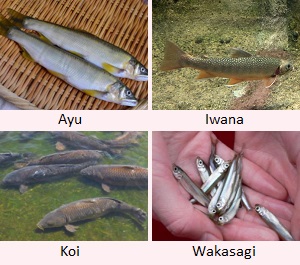
- Ayu (鮎, Sweetfish) : Ayu is a fish living in the stream of clear river.
It is living in the east Asia only around Japan, so the English name of the fish is "Ayu". (Sometimes, it is called as "Sweetfish")
Ayu goes down a river in autumn and spawns in the downstream.
Young ayu spends in the sea and comes back to the river in early summer.
So, ayu is caught in summer and is cooked by broiling.
The taste is mild and light. - Iwana (岩魚, Char) : Iwana is a fish living in the upper reaches of clear river.
Like Ayu, it is cooked by broiling.
The best season is early summer. - Koi (鯉, Carp) : Koi is a freshwater fish with very strong life force.
Wild carp are living even in dirty river, but Edible carp are cultured in the pond in the inland area. - Wakasagi (公魚, Japanese smelt) : Wakasagi is a small fish living in the cold lake in the northern Japan.
The main season is winter.
Mainly, it is cooked by deep-frying.
Shellfish
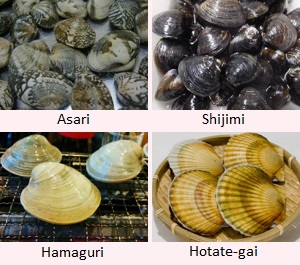
- Asari (浅蜊, Japanese littleneck clam) : Asari is a common shellfish in Japan.
The size is a few centimeters and each shell has different pattern.
The season are mainly spring and autumn, and in early spring, clam digging events are held at many sandy beach in Japan.
Asari is used for miso-soup, clear soup and some dishes. - Shijimi (蜆, Basket clam, freshwater clam) : Shijimi is a small black shellfish and lives in the sand in brackish water.
It is mainly used for miso-soup.
It is said that miso-soup of Shijimi is good for a hangover. - Hamaguri (蛤, Common orient clam) : Hamaguri is a tasty shellfish and the size is over 5 centimeters.
It is mainly used for clear soup and a few dishes.
The best season is early spring. - Hotate-gai (帆立貝, Japanese scallop) : Hotate-gai is a shellfish living in cold sea around Hokkaido and northern Tohoku regions.
Especially, the adductor muscle is soft and tasty and is used for sashimi and the other dishes.
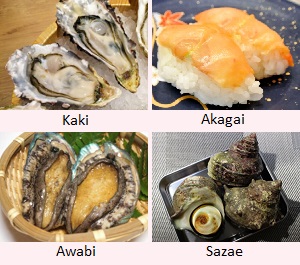
- Kaki (牡蠣, Oyster) : Kaki is a popular shellfish in the world.
Hiroshima and Miyagi prefectures are the main production center.
Surprisingly, eating raw oyster was introduced from Europe.
As Japanese cuisine, kai is used for pod dish etc. - Akagai (赤貝, Bloody clam) : Akagai is a shellfish with orange-colored flesh.
It is used for sashimi and sushi. - Awabi (鮑, Abalone) : Awabi is an expensive shellfish.
It is used for sashimi or broiled stake. The sashimi has hard texture. - Sazae (栄螺, Horned turban) : It is a kind of snail.
Mainly, it is cooked by broiling over an open fire.
Crab
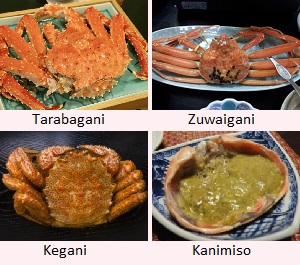
- Tarabagani (Red king crab) : Tarabagani is a big crab living in Okhotsk Sea, Bering Sea and the north part of Sea of Japan.
It is living in the deep part of the sea at about 200 to 300 meters deep.
Most crabs in Japan are imported from Russia and Alaska.
The best seasons are late spring and winter. - Zuwaigani (Snow crab) : Zuwaigani lives in the Sea of Japan and the northern Pacific Ocean.
It is also living in the deep part of the sea at about 200 to 600 meters deep.
In Japan, it is caught in the Sea of Japan and around Hokkaido.
Especially, the crab caught in the popular area has a brand name.
Fukui area = Echizen-gani
Around Tottori area = Matsuba-gani - Kegani (Horsehair crab) : Kegani is a crab living in the north part area of Japan.
Many short thorns are whole body but the flesh is tasty.
We can eat this crab throughout the year. - Kanimiso : After above crabs are boiled, innards inside of the shell of the body become like deep green or brown paste.
It is popular as a delicacy of marine products. (Foreigners may dislike it.)
It is used as an ingredient of sushi.
Other fishery products
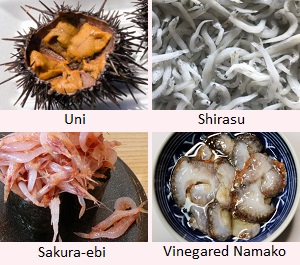
- Uni (海胆, Sea urchin) : Several kinds of sea urchins are edible and yellow-colored gonads in the spiny shell are eaten.
In Japan, it is mainly eaten raw and is one of sushi toppings.
The best season is summer. - Shirasu (白子, Whitebait) : Shirasu is small young fish such as type of sardines in the sea.
A large amount of Shirasu are caught, and are boiled in the water.
They are white and soft, and are used as the topping of various dish. - Sakura-ebi (桜海老, Sakura shrimp) : Sakura-ebi is a small shrimp living in the deep sea.
The color is pink, so the name of "sakura" (cherry blossom) is given.
In Japan, it is caught only in Suruga Bay near Shizuoka city and the fishing seasons are spring and autumn.
A large amount of Sakura-ebi are dried in the sun.
Mainly they are mixed in tenpura and okonomiyaki. - Namako (海鼠, Sea cucumber) : Namako is an animal crawling slowly on the seabed.
The body is grotesque but a kind of Namako is edible in Japan.
Mainly raw body is sliced and is pickled in vinegar.
It has a crunchy texture.
Roe
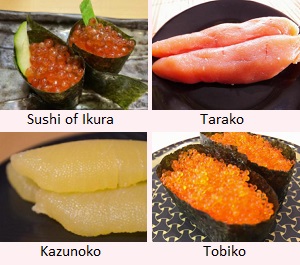
- Ikura (Salmon roe) : Ikura is roe of salmon.
Each roe is like a clear and orange-colored bead.
It is used for the topping of sushi and donburi dish (rice in a bowl).
By the way, the word is from a Russian word 'ikra' meaning roe. - Tarako (Salted cod roe) : Very small roes are wrapped with a thin skin.
Original color is pink, but it is often colored with red food coloring.
It is used for the topping of boiled rice.
Mentaiko is the product that tarako is dipped in the sauce of red pepper. - Kazunoko (Salted herring roe) : Very small yellow roes come together in a cluster.
The texture is a little hard.
It is used for one of of New Year dishes. - Tobiko (Flying fish roe) : Tobiko is roe of flying fish and very small roe is like a clear and gold colored bead.
It is mainky used for the topping of sushi.
Meat
Japanese people have been eating meats from very early times.
But, since 6th century, meat eating became a taboo in accordance with the teachings of Buddhism.
Nevertheless, it is a public stance and it appears to be true that people ate the meat of various animals such as boar, deer, bear, hare, raccoon and so on.
On the other hand, it would appear that cattle or hen were not eaten by reason that they were beneficial labor power.
In 1871 in Meiji period, the government lifted a ban on meat eating.
Because, Japan had to learn the advanced Western society to establish a modern nation.
Since this, Japanese people began to eat beef, pork and chicken.
Therefore, The Japanese dishes using meats has been invented after this time.
Beef
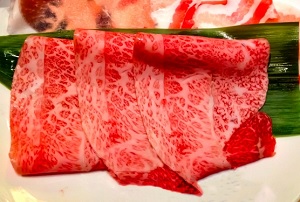
Kobe beef for Sukiyaki
Beef is commonly used by thin slicing in Japanese dish.
Because, knives and forks basically aren't used in Japanese meal.
And Japanese people like soft and fatty beef.
Such beef is used for the famous Japanese dishes, Sukiyaki or Shabu-shabu.
In Japan, there are very tasty and famous beef.
The four major Wagyu (Japanese beef) brands are Matsusaka beef, Kobe beef, Yonezawa beef and Ohmi beef.
The name means the producing city or area.
Additionally, there are the other several nice beef such as "Tajima beef", "Hida beef", "Maesawa beef" and so on.
But Wagyu is very expensive and imported beef is cheap.
60% of beef in Japan are imported mainly from Australia and USA.
Imported beef include lower fat than Wagyu, so the texture is a little harder than Wagyu.
Therefore, Japanese people think that Wagyu is a luxury food and imported beef is a daily food.
The beef of Wagyu has a high degree of marbled fat.
Japanese producers create such beef for Japanese people diligently.
But, some foreign people praise it, but the other foreign people may feel the taste a little fatty.
The differences in personal tastes might not be inevitable.
Pork
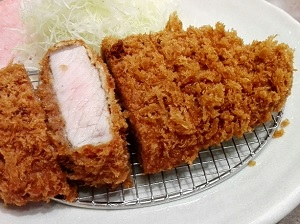
Tonkatsu
In Japanese cuisine, pork is not so much used as beef.
But, Japanese people also like Chinese cuisine or the dishes arranged in Chinese taste.
Pork is often used in such dish.
Famous Japanese dish using pork is Tonkatsu (Japanese pork cutlet).
And main ingredient of Okinawa dishes is pork.
In the Japanese home, pork is mainly used for Chinese dish or Western dish and shabu-shabu is sometimes used thin sliced pork instead of expensive beef.
Chicken
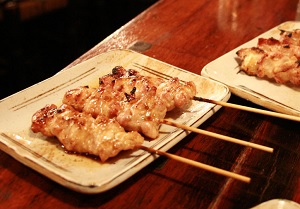
Yakitori
Chicken is light meat and makes tasty soup.
It fits into Japanese taste.
It is used for various Japanese dishes.
Yakitori is the famous skewered grilled chicken.
Like this dish, chicken is used by cutting small in Japanese cooking.
And, minced chicken is often used for Japanese cuisine.
Egg
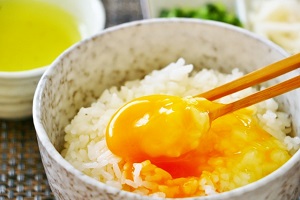
Rice with raw egg
Egg is one of the important foods in Japan.
Of course, it is chicken egg.
In a few dishes, quail egg is used.
In Japanese cuisine, simple dish of only egg is Dashi-maki Tamago (Rolled Omelet including Japanese Dashi soup).
It is used as a topping of sushi.
And there are many dishes made by adding beaten egg.
Chawan-mushi is made by steaming the soup including beaten eggs
In addition, Japanese people like to eat raw egg.
I hear many foreigners are surprised at such custom.
The producers of egg in Japan are performing a sanitary control sufficiently and all Japanese people take it for granted that raw egg is a safe food.
When you eat Sukiyaki, raw egg is served as the dip sauce.
After beating the egg, you dip the boiled beef into the egg sauce and eat it.
Boiled rice with raw egg is also a favorite dish of Japanese people.
After beating an egg with a small amount of shoyu (soy sauce), you pour it into the boiled rice and mix them.
When you stay in Japanese ryokan, it may be served as the breakfast.

